Film Lighting Overview
In a nutshell: The 4 main types of lights one would find on a film set are Tungsten, HMI, Fluorescent and LED panels. Each have their own quality, temperature and SPD. Additionally, bounce cards, flags, diffusers, barndoors, gels and lenses will be present too.
As a Lighting TD in Visual Effects, often time will be spent analysing the film lights used on the set. By using filmed plates, captured HDRIs, LIDAR, notes or witness photography, we can analyse the lights used whilst filming and derive light direction, broad colours and also the quality of the lights. A good exercise is also to see if you can identify exactly which light has been used. For example, if you can recognise a Kino Flo 4Bank, its an indication you’ll want a softer, rectangular light with a fluorescent-style light texture in your light rig.
In this blog post, I will write some broad information on the typical four types of lights used in film lighting. The screenshots of films in this post are captured from a fantastic Cooke Optics YouTube video here
When light hits a surface, the colour we see is a blend of the SPD of the light and the reflectance spectra of the hit surface, as well as the colour sensitivity of our eyes. With that said, when a cinematographer is deciding which lights to use on a film set, it is partly motivated by the story-telling and what they wish to convey through using this interaction of light, surfaces and how we respond to it all, in order “sculpt” the look and feel of a scene. If we break it down to a more practical level though, one can decide on which lights are most suitable based on their colour temperature (how orange or blue it appears), its CRI (colour rendering index, usually 85-90 is a good number) and the light quality (whether it is hard or soft)
Usually the cinematographer will have selected a variety of 4 main types of lights:
Tungsten - historic film lights, with a highly desirable orange-look
HMI - Big, brighter lights used for simulating daylight, with less power draw than Tungsten
Fluorescents - Inherently soft light with much less power draw than Tungsten or HMI
LEDs - Relatively newer lights that are very robust, do not require colour correction gels
Tungsten

A tungsten incandescent is basically a more powerful version of a common household bulb; warm and yellow light. Luminance is generated by heating the wire with a passing current trapped inside a glass or quartz environment filled with gas. Tungsten is the most traditional form of TV/Film lighting. They emit a very smooth spectrum of light, more so than any other artificial source making them highly desirable at producing tremendously natural skin tones.
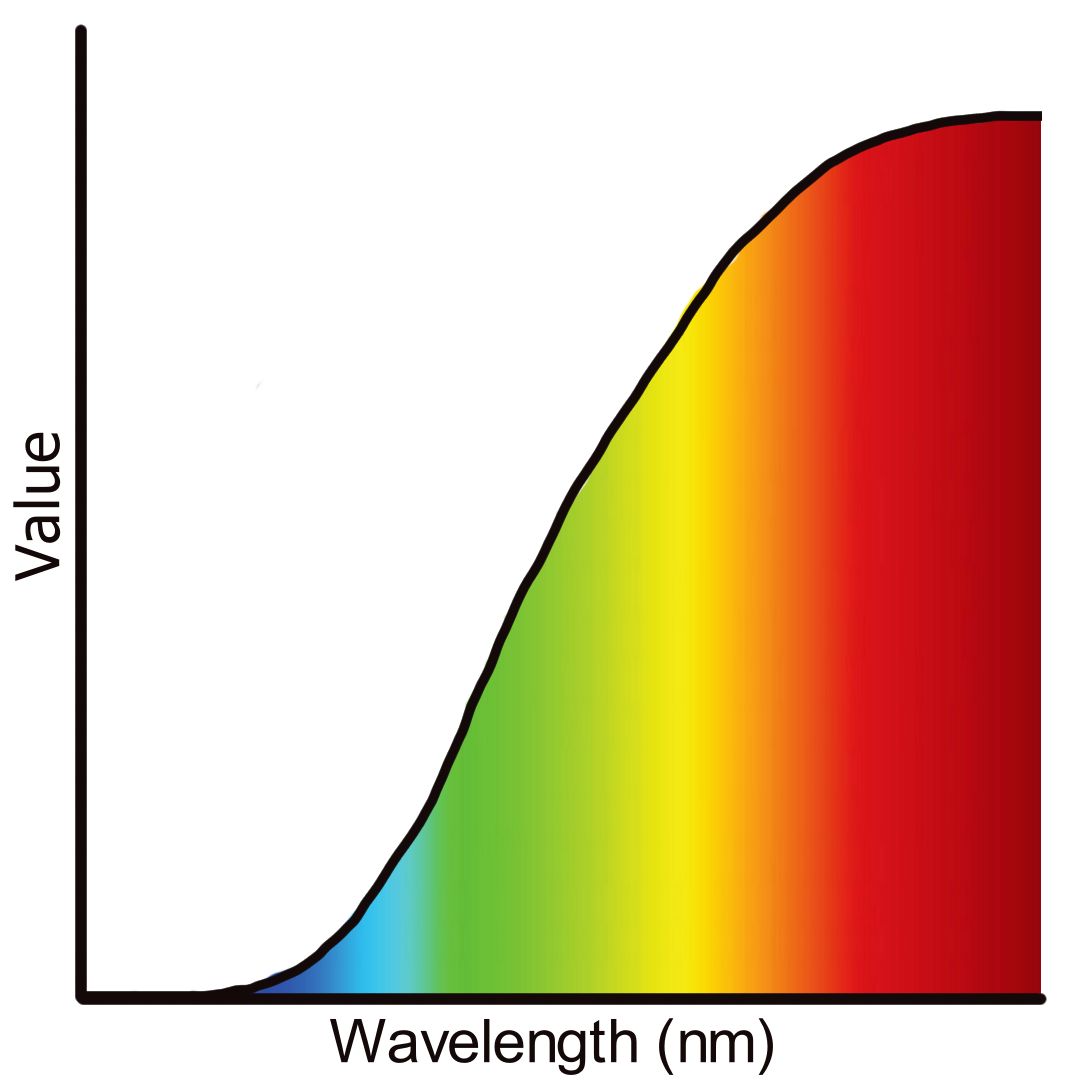
The light generated from tungsten will always be an orange hue, of approximately 3200K, this is one of the easiest ways to tell if one is looking at a tungsten. Tungsten can also be colour corrected to match daylight using a blue gel, but this will result in a very large loss of light output, however sometimes this trade-off is worth it to still take advantage of the smooth spectrum of light. Tungsten lights without any diffusion are considered “hard” lights, due to the harsh shadow it creates. They are also small bulbs and therefore can create quite harsh shadows without diffusion and shaping. Additionally, lenses are used to help focus the light.
Tungsten light is advantages due to its full spectrum of colour, it isn’t spiky and helps light skin really well. Because it is has been around for a long time, there is a wide selection of fixtures available, making them favourable to cinematographers. However, they are limited to the 3200K temperature, and any gel adjustments to colour correct them do result in significant loss in light intensity, around 1-stop.
If we were to apply this to CG as an example, a small sphere light would mimic an open-face tungsten pretty well. We also would want to set the colour to be an orange hue, but most modern renderers allow one to specify a Kelvin value directly, so setting it to 3200K works too. By using just a small sphere light, we will unfortunately end up with quite a harsh wash of colour with sharp shadows. We can remedy this by diffusing it. One option would be to place a CG plane in front and apply a translucent material to mimic fabric. However, this is not very efficient for light sampling methods so usually in CG it is more efficient for the integrator to just enlarge the light source and use a texture map to mimic the appearance of a layer of diffusion.

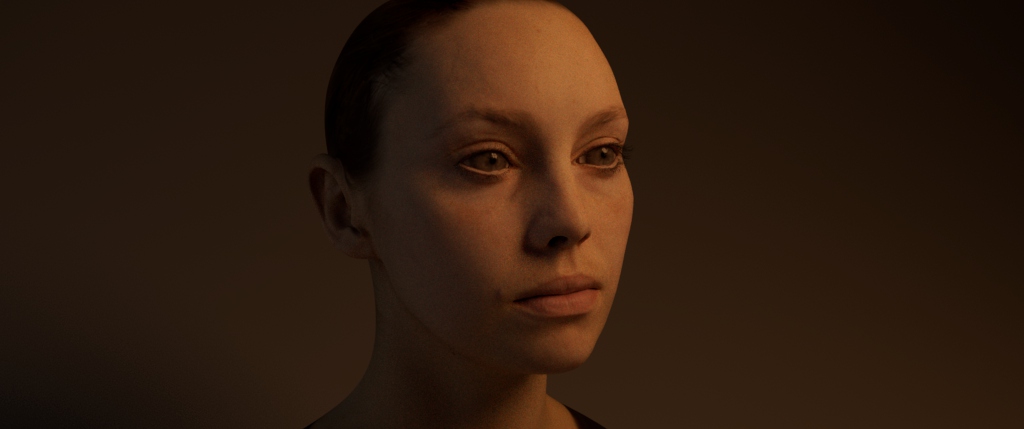
HMIs
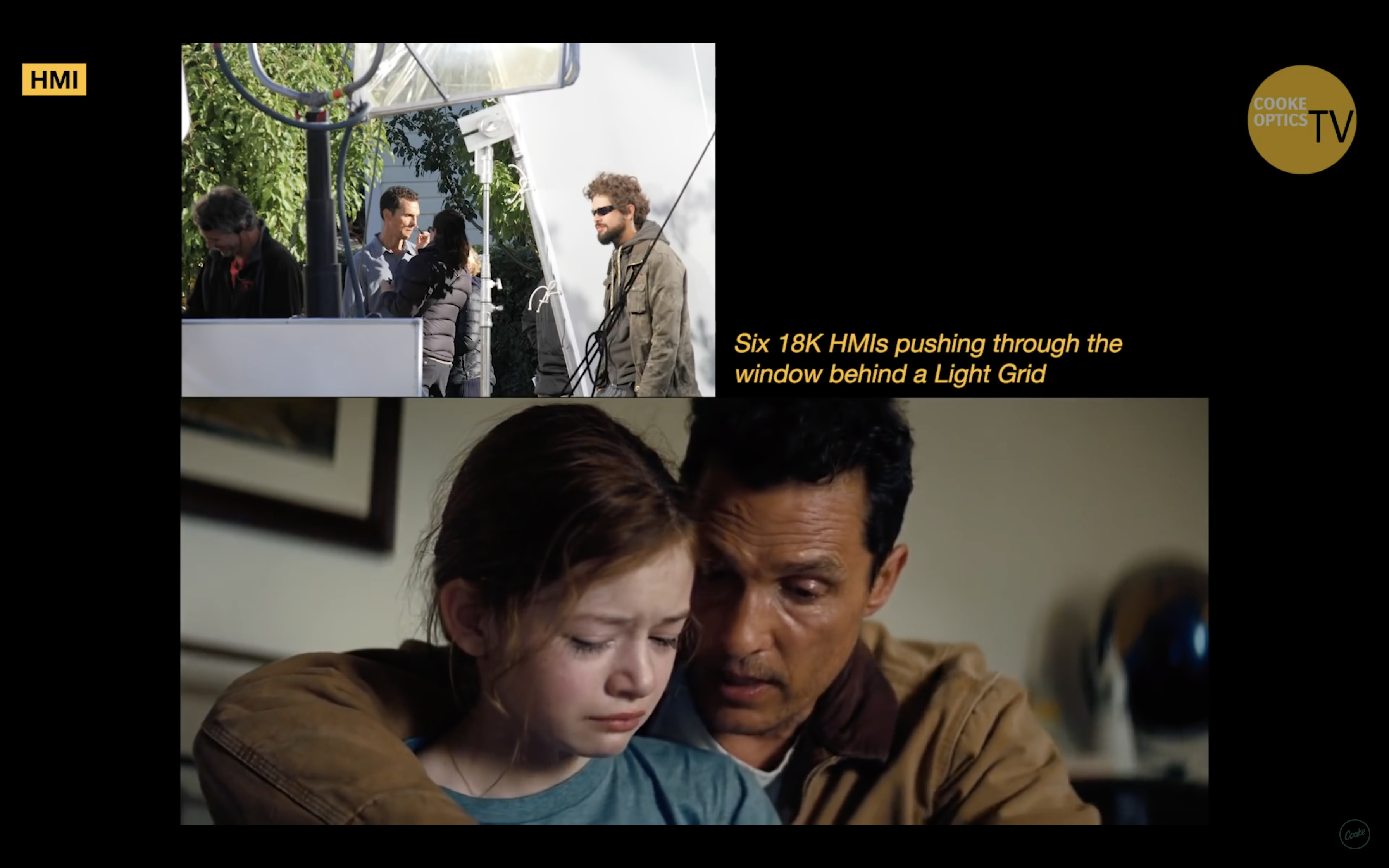
HMI (hydrargyrum medium-arc iodide) lights are closer to an expected daylight colour and thus are very often used for manufacturing sunlight on film sets. However, without any diffusion they can sometimes exhibit an “electronic” feel which is often overcome by using lots of bounce, book lighting, or by just using a layer of muslin to diffuse it.

The overall hue of an HMI has more of a blue temperature, contrary to the orange of tungsten. So this has a much better match of daylight temperature and most HMIs will produce a colour temperature of 5600K. Just like a tungsten bulb, an HMI is considered a “hard” light without any diffusion or shaping. However, they are very bright which means they often will be seen on film and TV sets when needing to either manufacture, or compliment natural lighting. Huge HMI lighting can be used to simulate night time, whereby the camera shoots at a white balance of 3200K, which naturally makes 5600K output of HMIs appear blue.
Applying this to CG can occur in a number of ways, it really depends how the HMI units are used on a film set. Is the HMI being used to simulate a sun? Then we are probably better off using a distant light and adjusting the cone angle to fit. Is it being used through lots of diffusion and shaping to achieve a soft light? Maybe a rectangle light with a softbox texture map applied is more appropriate. It really comes down to what the motivation behind the HMI unit used is. Usually for colour, a good starting point would be 5600K or a light blue, and adjust accordingly.

Fluorescent

Fluorescent lamps have been around for a while, often seen in office lighting and most buildings. However, due to their noticeable flickering and greenish tint (from the mercury) they weren’t used very often on film sets unless specifically targeting a sterile feel. Fluorescent lamps work by using mercury to emit UV radiation. This is converted into visible light by fluorescent substances (usually phosphor based) on the inner surface. Nowadays, fluorescents found on film sets use specifically designed colour corrected lamps that counteract the green spike in the SPD created by the mercury element and actually make for a very pleasing colour for skin on-screen (also flicker-free!). Although fluorescent tubes are available in many colours, they are generally supplied to match tungsten (3200K) or daylight (5600K) colour temperatures to enable use in varied environments. In fact, to achieve a colour in-between, one replace some of the tubes with 5600K and the others with 3200K, to achieve a colour in the middle.
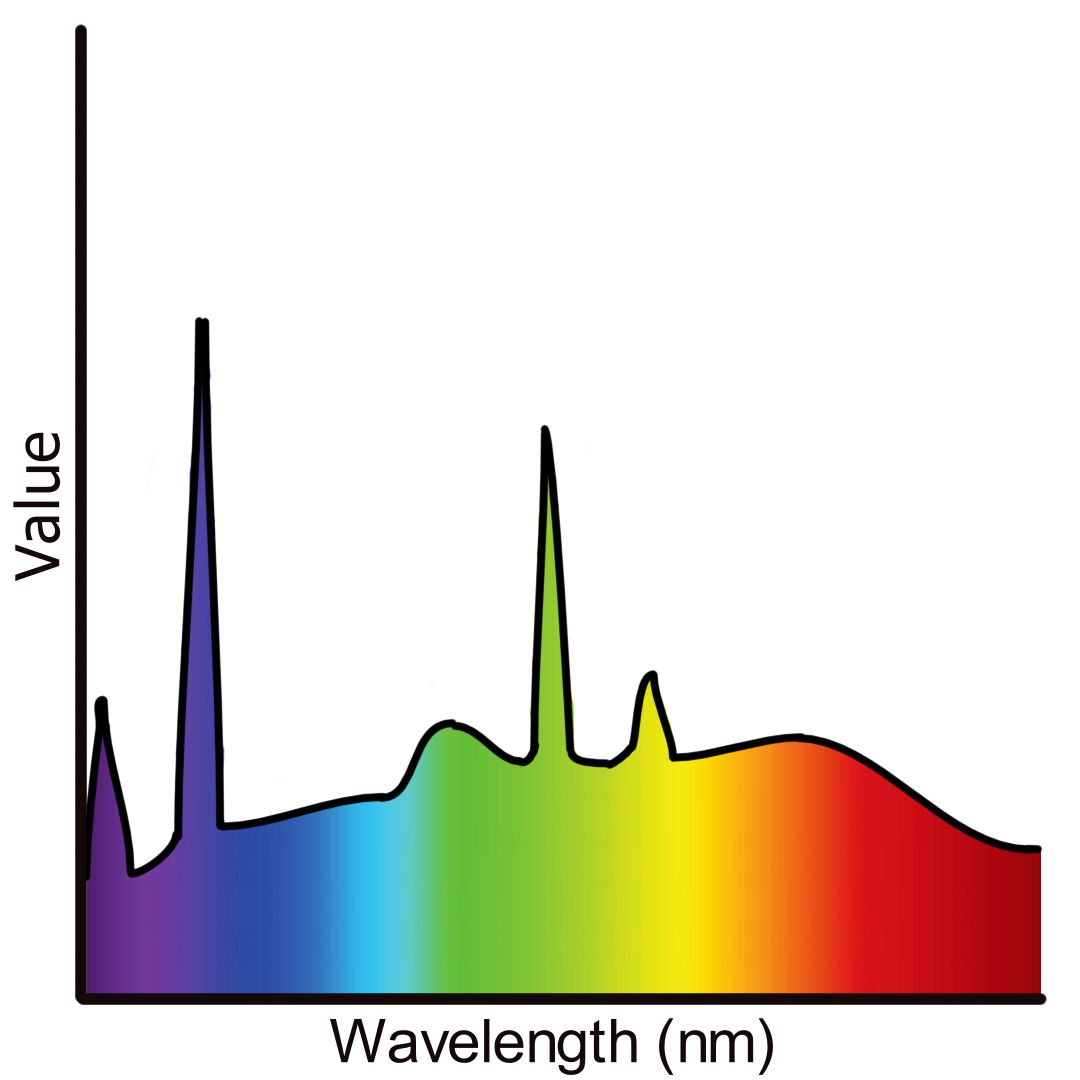
Unlike both tungsten and HMIs, fluorescents are deemed as a “soft” light. Because they are normally in units of 2s or 4s, they produce a very diffuse light from a large tube-like surface area and therefore tend to be soft. Due to the soft light they produce, they are generally viewed as a good light for skin- they are used a lot for TV interviews, fashion photograph and photoshoots. Normally fluorescents are used in film for fill lights, however combining multiple strong florescent lights together can enable one to get some beautiful key lighting. Kino Flos are the most popular brand of fluorescents, often seen whenever there is a green-screen (which is of course useful for their even, diffused light quality when keying green screen). Since they are not a small bulb like tungsten or HMI their shape is distinctively rectangular. As the surface area is large and emits such soft light, and the fact they are dimmable, one will rarely see them with any sort of diffusion paper on them. Additionally, due to individual bulbs being available in a variety of colours, one would not often need to use colour correction gels.
So, mimicking the appearance of fluorescents to CG is pretty straightforward. We could either use a large area light with a texture to mimic the 4 long tubes in a typical Kino Flo, or use 4 cylindrical lights in a row. Since fluorescents come in such a variety of colours, one should feel free to choose whatever works best for their scene, whether that be daylight or more synthetic, vibrant colours.

LEDs

Light emitting diodes are light sources that have become very popular in recent years as the technology has become more affordable- No longer are they mostly used on Science Fiction films. LEDs have been around since early 60s, but for decades only capable of emitting a weak red glow, restricting their application to TV standby lights and digital cocks. In recent years, the brightness and colour range of LEDs has improved dramatically, making them practical alternatives to traditional light sources. Compared to tungsten, HMI and fluorescents, LEDs are much more efficient, lightweight, generate less heat. They are fully dimmable without the colour temperature shift found in fluorescents. Unfortunately LEDs currently lack the raw power of large HMI/tungsten fixtures so can’t produce light intensities comparable to them. They can also often suffer from poor CRI. Additionally, due to the variety of sizes they are found in, another reason for their popularity in Science Fictions films was the lack of heat; LEDs are very safe to be around. Whereas with the more traditional lights sources, they are very hot and one certainly can’t put actors too near them. LEDs can be easily fitted in costumes/helmets and around people’s faces, or even on a spaceship desk board for interacting with actors. The main reason they haven’t become as popular as tungsten or HMIs or fluorescents is due to the spectrum of colour they emit. Unfortunately, they used to be very spikey and wouldn’t light up skin too well. However that has now changed and they are rapidly increasing in quality each year.

There are several types of LEDs, such as fixed colour LEDs, RGB lights, gel simulation LEDs. They are highly advantageous due to their ability to be very flexible in their available sizes and colours, however a limiting factor is their CRI and lack of raw intensity.
This is probably the easiest one to apply to CG! We can use a huge variety of sizes, and an array of squares to mimic the LED array texture, and use any RGB colour, just like LEDs that can mimic RGB colours.
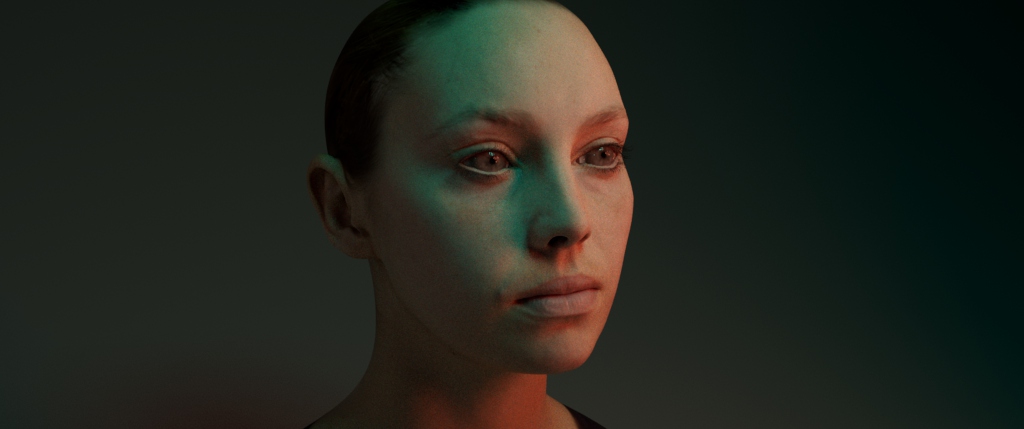
Summary
So that’s the main 4 lights one would find! It is also worth noting that there are many ways to manipulate and shape lights. So bounce cards would often be used on sets to add some extra fill light (usually on an actor’s face), likewise flags would be used to reduce bounced light to an area (for more contrasted looks). Gels are also used to tint the colours that lights naturally emit, to achieve the story telling goals. Lights can also be shaped via using fresnel lenses to focus the light beams or by using barn doors or gobos to block off, or filter the light. There’s many more tricks used, but hopefully this gives you an idea of how cinematographers and gaffers work with light on film sets to achieve story telling goals. Translating this to CG doesn’t mean we have to stick rigidly to “only using 3200K or 5600K lights”. I personally think if one can capture the characteristics of the lights that were used on set as a starting point, this can help achieve a solid first pass much quicker. I think it is a little similar to when a modeller or character artist learns anatomy in order to help arrive at a convincing digital human sculpt faster. Further, since most production renderers use RGB rendering, this means they do not model the complex SPDs the lights exhibit, by default everything has a smooth spectra. If one wanted to capture the exact behaviour and mixing of light colour with the interacted materials, one would need to use spectral rendering methods, though for the demands of production for VFX and Animation artists, usually RGB rendering is more than enough to get a stunning and convincingly photorealistic result.
That’s the end of this blog post! We covered the main 4 lights used in films, what their qualities are, and a rough idea of how to approximate them in a CG scene. Hopefully this has been a useful overview on the key types of lights.